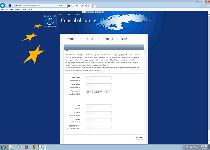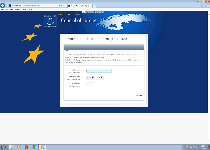Linkup Ransomware
Posted: February 4, 2014
Threat Metric
The following fields listed on the Threat Meter containing a specific value, are explained in detail below:
Threat Level: The threat level scale goes from 1 to 10 where 10 is the highest level of severity and 1 is the lowest level of severity. Each specific level is relative to the threat's consistent assessed behaviors collected from SpyHunter's risk assessment model.
Detection Count: The collective number of confirmed and suspected cases of a particular malware threat. The detection count is calculated from infected PCs retrieved from diagnostic and scan log reports generated by SpyHunter.
Volume Count: Similar to the detection count, the Volume Count is specifically based on the number of confirmed and suspected threats infecting systems on a daily basis. High volume counts usually represent a popular threat but may or may not have infected a large number of systems. High detection count threats could lay dormant and have a low volume count. Criteria for Volume Count is relative to a daily detection count.
Trend Path: The Trend Path, utilizing an up arrow, down arrow or equal symbol, represents the level of recent movement of a particular threat. Up arrows represent an increase, down arrows represent a decline and the equal symbol represent no change to a threat's recent movement.
% Impact (Last 7 Days): This demonstrates a 7-day period change in the frequency of a malware threat infecting PCs. The percentage impact correlates directly to the current Trend Path to determine a rise or decline in the percentage.
| Threat Level: | 10/10 |
|---|---|
| Infected PCs: | 9 |
| First Seen: | February 4, 2014 |
|---|---|
| Last Seen: | July 13, 2019 |
| OS(es) Affected: | Windows |
 The Linkup Ransomware is a recently-developed PC threat that capitalizes on European movements towards erotic website-filtering legislation to scam the inhabitants of that region, including, French, Italian and British residents, for example. Malware researchers were unsurprised to see the rise of yet another European Trojan dedicated to faking an affiliation with the local law enforcement, but the Linkup Ransomware does have its unique qualities, such as demanding payment through methods that enable its criminals to engage in credit card fraud. Browser hijacks or other symptoms common to the Linkup Ransomware should be used as springboards into action with anti-malware tools that can remove Linkup Ransomware and other malware that often is installed with the Linkup Ransomware.
The Linkup Ransomware is a recently-developed PC threat that capitalizes on European movements towards erotic website-filtering legislation to scam the inhabitants of that region, including, French, Italian and British residents, for example. Malware researchers were unsurprised to see the rise of yet another European Trojan dedicated to faking an affiliation with the local law enforcement, but the Linkup Ransomware does have its unique qualities, such as demanding payment through methods that enable its criminals to engage in credit card fraud. Browser hijacks or other symptoms common to the Linkup Ransomware should be used as springboards into action with anti-malware tools that can remove Linkup Ransomware and other malware that often is installed with the Linkup Ransomware.
The Ransomware that Links Your PC Up with Fraudsters
While the widespread influence of fake Police Trojans and Ukash Viruses of various stripes cannot be denied, some criminals appear to be unhappy with the already-massive profits created by these PC threats. The Linkup Ransomware is a new variant on the same tactic used by such threat, and, like them, displays fake warning messages about illegal computer activities that the Linkup Ransomware claims originate from a lawful source. Although English language samples of the Linkup Ransomware's warning messages are widely available, it should be stressed that the Linkup Ransomware most likely modifies the language of its alerts to tailor them to the nation of the victim (as per the detected IP address).
The Linkup Ransomware uses one of the most common hoaxes related to Police Trojans and other forms of ransomware that mimic the actions of law enforcement agencies: the Linkup Ransomware claims that your PC has been detected visiting underage pornography websites. However, rather than blocking most other programs on your PC, the Linkup Ransomware contents itself with blocking your Web browser. These hijack attacks only can be resolved by removing the Linkup Ransomware, and malware experts particularly urge you to avoid giving any personal information to the Linkup Ransomware, which demands a variety of identity and financial information in exchange for restoring your browser.
Unlinking Your Browser from a Browser-Hijacking Linkup Ransomware
Although you may find it troublesome to be unable to browser other sites while the Linkup Ransomware is redirecting you to its fake legal warning, the Linkup Ransomware isn't the only thing that its victims need to worry about, and also has been found installed with other forms of threats. Current evidence indicates that the Linkup Ransomware may be installed along with a risky Bitcoin miner, which malware researchers often find generate semi-obvious symptoms, such as poor system performance and excessive CPU/GPU usage. Allowing a Bitcoin-mining Trojan to perform its actions indiscriminately may cause permanent damage to your PC, to say nothing of the security issues raised by the Linkup Ransomware, alone.
Giving the Linkup Ransomware your credit card and other information is nothing more than giving criminals free reign to assume your identity and make fraudulent charges, and there aren't any advantages to doing what the Linkup Ransomware wants. As a safe, alternative solution, malware researchers would recommend booting your PC through any safe peripheral device, such as a free USB drive. With that accomplished, you should be capable of using the proper anti-malware products to remove the Linkup Ransomware and its fellow Bitcoin miner (identified as Protominer) and any additional PC threats.

Technical Details
File System Modifications
Tutorials: If you wish to learn how to remove malware components manually, you can read the tutorials on how to find malware, kill unwanted processes, remove malicious DLLs and delete other harmful files. Always be sure to back up your PC before making any changes.
The following files were created in the system:file.exe
File name: file.exeSize: 167.93 KB (167936 bytes)
MD5: f1304992523cd68f7412a355d2fb9d5d
Detection count: 78
File type: Executable File
Mime Type: unknown/exe
Group: Malware file
Last Updated: February 4, 2014
Additional Information
| # | Message |
|---|---|
| 1 | The Provisions on the fight against sexual exploitation of children and child pornography on the Internet complies with the provisions of a EU Council decision from December 2003. It gives the police powers to arrest those who are responsible for child pornography, calls for the creation of the National Centre to combat child pornography on the internet and establishes that Internet Service Providers have a legal obligation to adopt a filtering system to avoid access to sites censored by the Centre. |
Leave a Reply
Please note that we are not able to assist with billing and support issues regarding SpyHunter or other products. If you're having issues with SpyHunter, please get in touch with SpyHunter customer support through your SpyHunter . If you have SpyHunter billing questions, we recommend you check the Billing FAQ. For general suggestions or feedback, contact us.